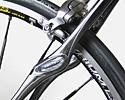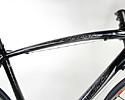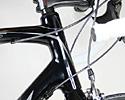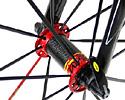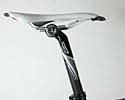
Recently on Cyclingnews.com |
On Test: Specialized S-Works Roubaix SL, April 24, 2007
So good, they named a town after it...
Specialized has long been famous for bringing an edgy perspective to bike design, so when it decided to come up with a bike to tackle the toughest race of them all - the mythical "Enfer du Nord" itself - you just knew it'd come up with something a little bit different from the norm. We've already had a bit of a go on the new Specialized S-Works Roubaix SL at product launches in June and July last year, but that taster only proved to whet our appetites. Cyclingnews' Ben Atkins gives it an extended test to see if the bike lives up to its esteemed namesake.
We really got it together baby...
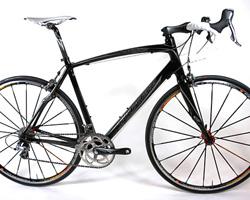
|
What hits you first when you take the Specialized S-Works Roubaix SL out of the box (or see it in the shop window) is the striking, curvy styling. Technically speaking, the Roubaix SL is a semi-monocoque FACT 10r carbon fibre frame, made using Specialized's Az1 carbon construction method. What the company actually did, though, was take the original designs for Marilyn Monroe, combine them with a certain cola bottle, and then stick a wheel on each end - I had to stop myself from asking for the bike's phone number!
Specialized has borrowed some distinctive design features from its Tarmac frame for its top-level Roubaix (especially that bowed top tube) to impart a racier look and supposedly stiffer frame, but has modified the geometry in keeping with the slightly more relaxed theme of the rest of the model line. In addition to the extended head tube, our 56cm test model wears 10mm longer chain stays, a 1° slacker head tube angle, and 6mm more fork rake as compared to the Tarmac, resulting in a fairly rangy 1010mm wheelbase (an increase of 24mm). Evidence of this can be seen quite clearly with the naked eye, in the form of the massive amounts of fresh air visible between the tyres and the seat and down tubes.
Moving away from the front triangle is the area that Barry White would really want to write songs about. Specialized retains the Zertz elastomer damping inserts of the original carbon Roubaix for the new FACT carbon fork and seat stays on the S-Works SL model, but the radical restyling now turn the areas into real works of art. More importantly, however, Specialized claims the curvier styling also adds 5.6% more vertical compliance as compared to last year's carbon Roubaix as well as torsional and bottom bracket stiffness increases of 10% and 2%, respectively.
The frame is finished in subtler-than-you'd-expect silver and white outline graphics. This scheme is a little minimal for my own taste, but they do give you a chance to admire as much of the carbon as you want to. As the current trend seems to be, there is no obvious weave on display beneath the clearcoat - no matter since that layer is mostly cosmetic, anyway.
The set-up
Our test bike was adorned with a pair of beautiful Mavic Ksyrium ES wheels and an almost complete Shimano Dura-Ace groupset - the exception being the Specialized FACT carbon compact chainset with 50/34T rings. The rest of the finishing kit is an almost completely in-house affair: the SL FACT carbon seat post continues the Zertz theme and also holds the Toupé saddle in place, and the comfort theme is extended to the front end with Specialized's Bar Phat gel pad and tape system. Naturally, those are attached to a carbon S-Works SL handlebar and S-Works carbon stem .
The whole thing amounts to just under 7.1kg (15.7lb) without pedals, which is pretty good considering it's not specifically built to be a featherweight mountain machine.
You've got the Look, but have you got the Touch?
Okay, it looks sexy, it's named after my favourite race, but how does it work in the real world? I've lost count of the number of bikes named after famous cols that would have trouble making it up on top of a car, let alone under human power. After all, just because something has a suggestive name doesn't necessarily mean it's at all suitable for the task it advertises. To be fair, Specialized aims the Roubaix SL squarely at the 'long distance in comfort' market and not just a pavé machine, hence its proud claim that the "Roubaix makes choosing between going fast and going long a thing of the past". Given the bold name choice, though, we couldn't help but feel a responsibility to our readers to properly investigate…
As part of the test, I managed to persuade a few friends to come with me on a bit of pre-Classics reconnaissance, where we'd ride the climbs of Flanders and the cobbles of Roubaix - all in the name of research, of course! The weekend was neatly divided in two as we'd travel to Belgium on Saturday and do as many of De Ronde's climbs as we had time for, then an early start on Sunday would see us attempt to ride all of the cobbled sectors from this year's Paris - Roubaix. In all, the weekend was to total something close to 300km (186mi).
This may seem a bit extreme, but there was a kind of method in my madness. This bike is designed to eliminate as much road buzz as possible, and there are no roads in the world that I know of that buzz like Roubaix cobbles. If I could do a good distance over these roads and still feel relatively fresh, then the bike must be doing something right.
We managed our 300km of Flanders and northern France, and despite the fact that it was pretty much nighttime by the time we reached the Roubaix velodrome, I have to say that I still felt surprisingly fresh. Make no mistake, the cobbles were still very tough to ride, but the Roubaix SL definitely absorbed the very harshest sting of each one, making the passage from one stone to the next much less of a leg-sapping experience than I've experienced on stiffer bikes. Consequently, even as we traversed the last few sectors, and covered the last few kilometres through Hem and into the outskirts of Roubaix, I was able to keep applying the power all the way to the finish line.
Back in the real world on my usual training routes, this slight damping of cobbles translated well to the smoothing of the worn tarmac surfaces of the roads of Sussex. Training rides were as tough as usual (and my legs were still sore), but the Roubaix's excellent buzz-eliminating properties noticeably lessened that non-specific fatigue that I often feel after a ride.
So the frame is compliant and forgiving in the vertical plane, making long rides more comfortable, but this is no use if it also flexes laterally, thus wasting your carefully applied energy. In this department, I also found the Roubaix SL to perform outstandingly. Not being the world's greatest climber, I tend to grind a bigger gear than perhaps I should, and so I generally notice if the bike is flexing. On short sharp power climbs and longer drags alike, I never felt the bottom bracket sway at all even when out of the saddle. Moreover, there was no perceptible twisting at the front end -either from the frame's front triangle, or from the über stiff bars and stem - nor did I ever get the sensation that the chain stays were bending under load.
The wheels - despite being more what you'd describe as a climbing wheel - took everything I threw at them in stride (even fifty-odd kilometres of the roughest surface in Europe!) and remain as straight and true as when I first put them on. The Dura-Ace groupset was as predictably predictable as you'd expect - it's so good, in fact, that I have a theory that Shimano has to make the styling as outlandish and controversial as it does because otherwise you might forget it's there.
Conclusion
Even with my fussy head on there's still not much to find wrong with the Roubaix SL. From a fit for purpose perspective it pretty much ticks all the boxes: it makes the pavé of northern France and Belgium a bit more palatable, but it also satisfies the more general role of making riding long distances a forgiving experience without compromising performance.
Aesthetically, I reckon it's one of the best-looking frames out there; the subtle graphics and clearcoat finish is beautifully understated and has so far resisted chips and scratches. The only criticism of the overall look I can make is that the rear brake cable looks a little bit strange stretched straight as it is below the bowed top tube.
About the only thing I did find wrong with the complete set up was the fact that it comes with a compact chainset and a 12-27T cassette. Even for the bergs of Flanders, and a non-climber like me, the lowermost 34x27T combination is a bit small, and the large range of sprocket sizes necessitates bigger gaps than is ideal.
In all, this is a great bike, well worth it if you want to race or ride all day, but still have the energy to go for a beer afterwards.
[Many thanks to the Velo Club de Roubaix and Les Amis de Paris-Roubaix for granting me access to the Roubaix velodrome.]
Weight: 7.1kg (15.7lb) (w/o pedals or bottle cages)
Price: US$6000
Pros: Stiff, yet comfortable; great looking; very light; virtually unstainable
bar tape
Cons: Gear ratios a bit small; rear brake cable looks a bit strange
Cyclingnews rating: ![]()
Photography
For a thumbnail gallery of these images, click here
Images by Ben Atkins/Cyclingnews.com
- The Specialized S-Works Roubaix SL : a truly sexy bike.
- Specialized's FACT chainset featuring an integrated oversize bottom bracket.
- The FACT carbon monocoque fork with curvy lines, extra rake, and Zertz inserts.
- The Roubaix SL's extended head tube offers up a slightly more upright seating position.
- Curvy and straight tubes seamlessly join each other making for a smooth seat tube area.
- This is what the fuss is all about : vibration-damping elastomer Zertz inserts make the road that little bit more comfortable.
- The Roubaix's slinky seat stays house the Zertz about two thirds of the way up.
- Zertz all the way even in the FACT SL seatpost. A very beefy clamp securely holds the Toupé Gel saddle.
- The bowed top tube looks a little strange with the rear brake cable stretched across the gap.
- An oversized four bolt clamp on the S-Works carbon stem securely holds the carbon bars in place.
- From the front you can appreciate the sheer size of the Roubaix SL's head tube.
- Rainbow bands adorn the seat tube in memory of Super Mario's 2002 victory - not the fact that the current Campione rides one!
- Ever dependable Dura-Ace ; if it wasn't this big you might forget it's there!
- The oversized down tube joins the seat tube and chain stays at a massively reinforced bottom bracket area.
- More curves on the chain stays arc inwards towards the spokes before flaring out to the hub.
- Mavic knows a lot about what makes a pair of wheels look good…
- … I could stare at these hubs all day…
- S-Works Roubaix tyres feature a 23mm tread on a 25mm casing, creating a fast tyre that's also quite forgiving.
- The seat stays continue curving right up to where they join the seat tube.
- An all Dura-Ace drivetrain except for the S-Works chainset. A pair of compact rings with a 12-27T cassette allows for a very small gear - a bit too small?
- You could put cross tyres on if you wanted! The longer wheelbase makes for a lot of tyre clearence at both ends of the bike.
- Very subtle graphics allow you to admire as much of the carbon fibre as possible.
- Specialized's Bar Phat on top of the FACT carbon aero bars makes for a comfy place to put your hands.
- I challenge you to stain this tape! I got it dirty several times with an assortment of nasty road muck and it keeps coming off!
- If proof were needed, here's the test bike at it's spiritual home - the Arenberg Forest.
Images by Jay Chisnall/Cyclingnews.com
- Our hardman bike tester on a solo attack through the Forest of Arenberg.
- It works in Flanders, too. Our classics specialist climbs the Steenbeekdries.
Images by Ben Atkins/Cyclingnews.com
- How else do you clean a Roubaix bike but in the mythical showers at the Roubaix velodrome!
Full Specification
|
Frame: S-Works FACT 10r carbon, Az1 construction, Zertz inserts |
Shift levers: Shimano Dura-Ace ST-7800 |

